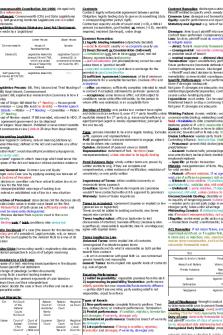Lecture notes, cheat sheet for final exam PDF

| Title | Lecture notes, cheat sheet for final exam |
|---|---|
| Course | Principles of Business Law |
| Institution | University of Melbourne |
| Pages | 2 |
| File Size | 92.4 KB |
| File Type | |
| Total Downloads | 53 |
| Total Views | 138 |
Summary
Cheatsheet for final exam ...
Description
Commonwealth Constitution Act 1900: changed only with a referendum Parliament: Commonwealth (Cth) and State Legislatures only. Self-governing territories Legislatures are not called Parliaments. Legislation/Statute/Statutory Law/Act/Enactment: law made by a Legislature/ Lower House
Upper House
Commonwealth
House of Representatives
Senate
States (6)
Legislative Assembly (except SA and TAS, which are called House of Assembly instead)
Legislative Council (except QL is unicameral and does not have the UH)
Self-governing territories ACT/NT/NI (3)
Legislative Assembly
–––
Legislative Process: Bill, First, Second and Third Reading of a Bill, Royal Assent, Commencement Proposal: Bill, explanatory memorandum (summary & how it works) House of Origin: Bill listed for 1st Reading → House grants permission → Long title read (no debate) → Minister speech → Debate → Motion → 2 nd Reading → Committee → Motion → 3rd Reading House of Review: repeat. If Bill amended, returned to HOO. If no agreement government can be dissolved Final stages: Royal Assent. Published in Government Gazette. Act commences as law ( default 28 days from Royal Assent) Interpreting Legislation Literal Approach: ordinary, natural meaning (dictionary) Special Meaning: defined in the Act and overrides any other meanings “Golden Rule”: avoid absurdity/inconsistency/repugnance. Very rarely used. “Purpose” approach: attach meanings which best serve the purpose of the Act and based on intrinsic/extrinsic evidence Case/General Law: Common Law and Equity Judges make Case Law by applying existing law because of the Doctrine of Precedent → declare an unwritten rule from natural/custom law as an AU law for the first time → interpret/establish meanings of existing laws → extend an established rule of law to a new situation Doctrine of Precedent: stare decisis (let the decision stand) decide similar cases in similar ways based on the first. → Material facts of both cases are sufficiently similar and cannot be reasonably distinguished. → Previous decision from superior court in the same hierarchy. → Binding only if both conditions; else persuasive Ratio Decidendi of a case (the reason for the decision): the binding part of a precedent. Legal principle, rule, or reason which the court applied to the material facts to arrive at its decision Obiter Dicta (surrounding words): explanatory discussion, historical perspective & account of judge's reasoning Procedure in a Civil case: Purpose of a trial: resolving issues/questions in the dispute between plaintiff and defendant Exchange of pleadings (written documents) Proving facts: ascertain leading evidence Ascertaining law: present arguments of case based on relevant laws and their interpretations Decision: decide the case in favor of either and make an appropriate order
Contracts Contract: legally enforceable agreement between parties Obligation: legally binding duty to give or do something (duty = corresponding/other party's right) Contractual capacity: adults of sound mind (>18), artificial persons (corporations, govt bodies) vs minors (...
Similar Free PDFs

Cheat sheet final exam
- 3 Pages

Final Exam Cheat Sheet
- 2 Pages

Final Exam Cheat Sheet
- 4 Pages

Final Exam Cheat Sheet
- 2 Pages

Final Exam Cheat Sheet
- 7 Pages

Final Exam Cheat Sheet
- 2 Pages

Final Exam Cheat Sheet
- 2 Pages

Exam cheat sheet used for final
- 20 Pages

Stats Cheat Sheet for Final Exam
- 9 Pages

LLAW1001 Final Exam Cheat Sheet
- 12 Pages
Popular Institutions
- Tinajero National High School - Annex
- Politeknik Caltex Riau
- Yokohama City University
- SGT University
- University of Al-Qadisiyah
- Divine Word College of Vigan
- Techniek College Rotterdam
- Universidade de Santiago
- Universiti Teknologi MARA Cawangan Johor Kampus Pasir Gudang
- Poltekkes Kemenkes Yogyakarta
- Baguio City National High School
- Colegio san marcos
- preparatoria uno
- Centro de Bachillerato Tecnológico Industrial y de Servicios No. 107
- Dalian Maritime University
- Quang Trung Secondary School
- Colegio Tecnológico en Informática
- Corporación Regional de Educación Superior
- Grupo CEDVA
- Dar Al Uloom University
- Centro de Estudios Preuniversitarios de la Universidad Nacional de Ingeniería
- 上智大学
- Aakash International School, Nuna Majara
- San Felipe Neri Catholic School
- Kang Chiao International School - New Taipei City
- Misamis Occidental National High School
- Institución Educativa Escuela Normal Juan Ladrilleros
- Kolehiyo ng Pantukan
- Batanes State College
- Instituto Continental
- Sekolah Menengah Kejuruan Kesehatan Kaltara (Tarakan)
- Colegio de La Inmaculada Concepcion - Cebu





